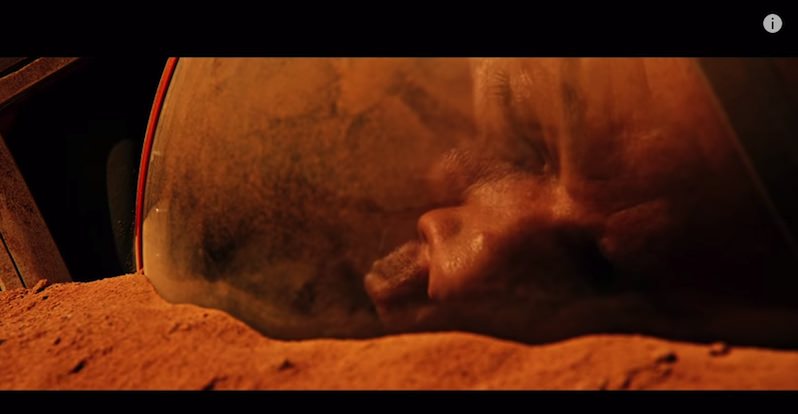What Do the Pope and ‘The Martian’ Have in Common?
The science fiction film starring Matt Damon is a timely cautionary tale for us fellow travelers on Spaceship Earth. Pope Francis gets it, as his climate change encyclical shows. Will the rest of us?
For science fiction fans, the news that Ridley Scott had optioned Andy Weir’s award-winning novel “The Martian” and hired Matt Damon to star in it was probably a bigger deal than the announcement that Pope Francis would issue an encyclical on climate change. The encyclical came out this week. The movie is scheduled for a November release, but a goose-bump-producing trailer is already out. (Note to those still planning to read the novel or see the movie: The account below includes spoilers. Watch the trailer below.)
The book tells the story of Mark Watney, a botanist and part of the first NASA expedition to the Red Planet, who is stranded on Mars when the rest of the crew flees a sandstorm and leaves him for dead. Watney has a habitat structure and a way of making oxygen, and he is even able to construct and keep a potato garden for a while. He makes an expedition to recover communications equipment from the Mars Pathfinder roving probe, launched in 1996, and gets in touch with NASA. His daily extravehicular activities, observed from satellite, rivet the world on his plight and do for cable news what, in real life, Malaysian Flight 370 did when it went missing in 2014.
Those back on Earth pull for him to survive and return, aware of the real possibility he could run out of food and starve. Ultimately, the Chinese volunteer to help his crew, which had returned to Earth’s vicinity, go back out and try to rescue him. This plan requires, however, that he make a long trek to a pre-positioned Mars Ascent Vehicle at a different site, intended for use on a future mission. Can he make it through a gathering enormous, months-long sandstorm? Simon Sharwood correctly observed that in this book, there are no human villains and that Mars itself serves as the antagonist, with science in many ways being the hero as much as Watney.
The relevance of Weir’s “The Martian” to our national climate change debate is that the composition of the atmosphere, and what it means for human survival, plays a key role in the book on more than one occasion. For the most part, failure to understand basic science drives denialism in the general public and among politicians (at least for those of the latter who aren’t just on the take from Big Oil). If we listened only to the scientists who actually have expertise in climate science and actively publish on it in peer-reviewed publications, the widely touted 97 percent estimate for the consensus on human-produced climate change would be a gross underestimate. In fact, the science is settled, save for a handful of contrarians or paid trolls.
Why is Watney’s Mars so cold that he can’t be outside save in a functioning spacesuit? Some 3.5 billion years ago, Mars may have been like Earth: wet and relatively warm. It is now cold because Mars’ atmosphere lost its carbon dioxide. Over time, carbon dioxide tends to get absorbed by igneous and other rocks, making carbonate and taking it out of the atmosphere. This happens on Earth as well. But on Earth, the carbon very slowly, over millions of years, gets released again because of the activity of our planet’s crust, which also causes earthquakes.
Mars is a much smaller planet than Earth, too small to have plate tectonics. So once it has bound to rocks on Mars, the carbon dioxide stays locked up. The resulting thin atmosphere makes for a minus 60 degrees Celsius temperature (minus 140 degrees Fahrenheit) in the temperate zones in the summer and minus 153 C at the poles (minus 307 F). The warmest it gets is at the equator, at noon on a summer day, when temperatures might rise to a tropical 21 C (70 F).
That Mars is generally unsuited to human life because of the lack of carbon dioxide in its atmosphere has inspired generations of science fiction writers to propose “terraforming” it, or making its atmosphere more like Earth’s, by finding a way to put greenhouse gases into it. This notion is the premise of Kim Stanley Robinson’s “Mars Trilogy.” Robinson even has his human colonists debate whether to change the planet or preserve its natural state. If only we could get Big Coal and Big Oil to relocate to Mars, they might make themselves useful, warming up a cold planet instead of overheating an already warm one.
Weir’s Watney is understandably consumed with the climate of his small habitat. He has an oxygenator, which breaks apart carbon dioxide (CO2) and gives oxygen back. His extravehicular forays are limited because his spacesuit lacks this capacity and carbon dioxide will build up inside it, making its atmosphere toxic. Watney uses hydrazine fuel from the landing shuttle, from which he liberates the hydrogen, to mix with oxygen to make enough water to survive for months. A backup oxygen tank, however, almost kills him at one point by allowing too much hydrogen to build up in his habitat, which could have blown him up when he burned the hydrazine. Watney cannot survive without an exact accounting of the gases in his habitat’s atmosphere, and if he miscalculates, it could kill him.
We are all now in Watney’s shoes.
Ice cores, the composition of marine life shells, and other proxies have allowed scientists to gather a good idea of how Earth’s climate has changed over time. There has never been a time when so much carbon dioxide was added to the atmosphere so quickly as during the past 150 years, when humans began burning coal (and later petroleum and natural gas) to power their machines. We have gone from roughly 270 parts per million of carbon dioxide to about 400 since the late 1700s. The full impact of this change in our atmosphere will not be felt for centuries. It will take 50,000 to 100,000 years for the igneous rocks to wash the new carbon dioxide out of the atmosphere, though the oceans will absorb some of it much more quickly, turning them acidic and killing off many ocean species we now depend on for food.
Homo sapiens sapiens, our species, is only about 150,000 years old and has evolved, and civilization has advanced, during a relatively cool period of the late Pleistocene. We don’t know if we will do well under much warmer conditions, with megastorms, droughts and wildfires. We are creatures of an ice age with advancing and retreating glaciers that, however, never disappeared even in warmer subcycles. We have now reconfigured the atmosphere of Spaceship Earth to make, in time, a climate much more like that of the mid-Pliocene, which stretched from roughly 5 million years ago to about 2.5 million years ago. Before about 3 million years ago, it was 2 to 3 degrees Celsius warmer (3.6 to 5 degrees Fahrenheit) on average, and there was no ice cover over Greenland; ocean levels were 25 feet higher, which would cover most of our present coastal port cities.
Like Mark Watney on Mars, we on Earth have to be concerned about the buildup of this carbon dioxide in our spacesuit. Our spacesuit is Earth.
Your support matters…Independent journalism is under threat and overshadowed by heavily funded mainstream media.
You can help level the playing field. Become a member.
Your tax-deductible contribution keeps us digging beneath the headlines to give you thought-provoking, investigative reporting and analysis that unearths what's really happening- without compromise.
Give today to support our courageous, independent journalists.








You need to be a supporter to comment.
There are currently no responses to this article.
Be the first to respond.